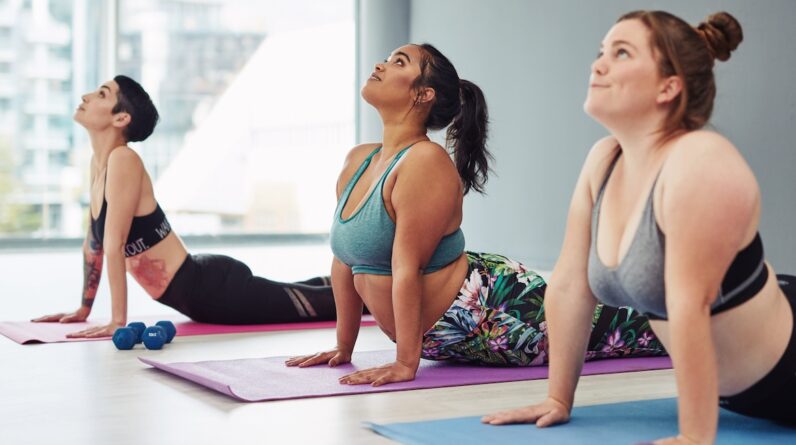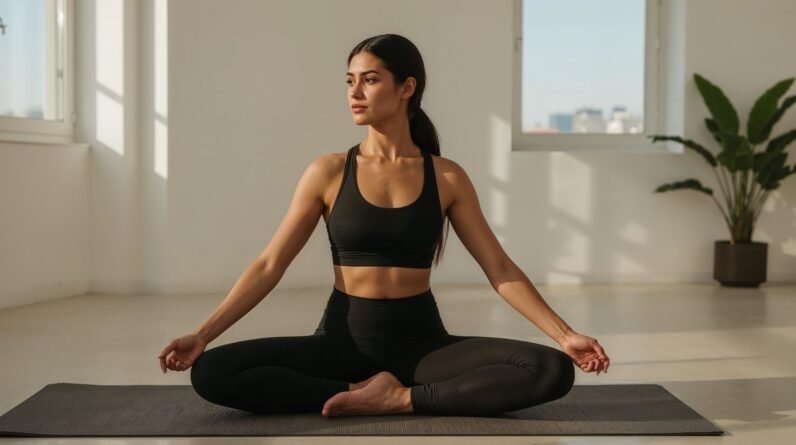
Exercise is often seen as “me time”—a moment to focus solely on yourself, your body, and your mind. So it’s no wonder traditional movement practices, whether it be weightlifting, running, or Pilates, are performed with earbuds in and zero small talk.
But there’s a case for incorporating some socialization into your fitness routine: Moving with others could enhance your well-being and longevity in the long run.
In a 25-year observational study of more than 8,500 people in Mayo Clinic Proceedings, researchers found that leisure-time sports that were inherently more social were linked with the best longevity. Study participants who played tennis, for instance, increased life expectancy by 9.7 years on average compared to sedentary individuals, while solo jogging enhanced life expectancy by just 2.3 years.
What’s more, researchers have shown that participating in regular group fitness classes for 12 weeks significantly reduced perceived stress and increased physical, mental, and emotional quality of life, according to a 2017 study of medical students in the Journal of Osteopathic Medicine. The participants who exercised solo, however, saw improvements only in mental quality of life.
And a 2023 review of 29 articles in Systematic Reviews showed evidence that participating in sports is linked with improved psychological well-being and social outcomes. Adults who participated in team sports had more favorable health outcomes than those who engaged in individual sports.
So how exactly does social-focused physical activity affect well-being—and potentially help you live a longer life? Here are the elements at play.
In This Article
-
01
Advantages of Social Exercise
-
02
How To Reap the Benefits
How social exercise can enhance your well-being
As with any wellness practice, highly social physical activities may not be the best fit for everyone, says Tony Kemmochi, PsyD, a sports psychologist with Intermountain Health in Salt Lake City. Folks who lean more introverted may thrive more in solo exercise settings, for instance.
“There are people who would benefit more from being in the group and environment, but there are also people who may actually feel more comfortable exercising alone,” Kemmochi explains.
Still, it’s not one-size-fits-all. So even if you’re shy or prefer solitude, give a more community-based movement practice a shot—you might just see some of the social benefits of exercise.
1. It increases accountability
When you have others relying on you to attend a pickleball match or a run club meet-up, you’re more likely to show up—even when your motivation is running low, says Megan E. Pietrucha, PsyD, a licensed clinical psychologist and sport psychologist in Chicago.
“It helps us feel like if our friend is going then we have to go, because we told them we were going to,” she explains. “We’re not going to flake out on our friend.”
With that added accountability, there’s a higher chance you’ll stick with the activity over time—meaning you’ll continue to get the mental and physical health benefits that come with movement for months or years to come.
“That team aspect to that can actually help with retention,” says Rochelle Eime, PhD, a professor of sport science at Federation University in Ballarat, Victoria, Australia. “So if you’re just going to go out for a run by yourself, you might go, ‘It’s a bit cold today,’ or, ‘It’s a bit windy today,’ or ‘I don’t feel like it today.’ Sometimes you can feel like that playing a sport, too. But you’re committed to that team, so you rock up and you make an effort, and then you feel better—because you’re communicating with them, and you’re generally having a good time. It’s much easier to just say no if you’re doing things individually.”
“Depression, anxiety, all of those things are correlated with isolation and loneliness. Being able to buffer against those things with a social aspect to exercise, I think people gain a lot from being able to work out with other people.” —Megan E. Pietrucha, PsyD
2. It makes movement more enjoyable
Moving with others is linked with4 more pleasurable exercise experiences, and some research5 even suggests training in a group creates a “heightened endorphin surge” compared to training alone.
“There’s also a neurobiological piece to it…[but] when you’re working out or participating with other people, it doesn’t feel strenuous on your body,” Pietrucha says. “You’re kind of distracted from the miserable aspects of it.”
Incorporating social elements into your fitness routine can also shift your perspective on exercise; it goes from being a chore to a rich activity you truly look forward to, Kemmochi says.
“When somebody’s taking up exercise more as a way to become healthy, they get trapped in this mindset that, ‘This is a task and I have to do it,’ and that becomes miserable,” he explains. “But to shift away from that, [toward], ‘Oh, this is a fun thing that we all do together,’ would just make it easier to engage.”
Just like the accountability piece, that joy of movement can make you more motivated to come back time and again.
3. It promotes learning
When you’re working out solo, you’re your own reference point, Kemmochi says. If you’re cycling with your bike seat adjusted incorrectly, there’s no one there to point out and help you correct the mistake, which could ultimately boost your performance and enjoyment.
But with a riding buddy or two, you can exchange notes and tips; maybe they tried something different and it ends up working better for you than your original set-up, Kemmochi says.
“We have blind spots. Maybe I notice things that they’re not aware of, and they notice things I’m not aware of,” he explains. “We can help each other learn more about ourselves, and from a skills acquisition point, it can also be helpful to have an opportunity to trace somebody. If you know there’s somebody on a team or group that’s really good at something, and you’re able to actually see it in person, it does make it easier for you to acquire the same skill if you’re there to observe and watch.”
4. It creates a community and instills a sense of belonging
Fundamentally, exercising with others gives you the opportunity to form a community and lasting social connections that can help protect mental health. Case in point: Findings from a 2021 study in Social Science & Medicine suggest that belonging to groups that engage in physical activity can protect against depression.
“We know that loneliness and isolation are highly correlated with other mental health conditions,” Pietrucha says. “We saw this during the pandemic: When people were really isolated, mental health issues were at a peak. Depression, anxiety, all of those things are correlated with isolation and loneliness. Being able to buffer against those things with a social aspect to exercise, I think people gain a lot from being able to work out with other people.”
These connections form not only between you and your peers or your coach but also the spectators, volunteers, and folks running the snack bar. The people on the sidelines may also experience the same sense of belonging, identity, and purpose as the athletes—even though they’re not getting active, Eime says. The more opportunities you have to engage with the world around you, the more you’ll feel certain about your identity, self-worth, and sense of belonging, Kemmochi adds.
5. It improves interpersonal relationships and emotional well-being
Participating in sports—and having positive experiences in them—at a young age can teach valuable life skills such as teamwork, cooperation, communication, and conflict resolution, Eime says.
In her 7research3 over the years, Eime has also seen personal benefits to participating in sports for children, such as emotional control, prosocial behavior, and a sense of belonging, she says. And those learnings can likely occur even when you’re playing in a rec soccer league or tennis club as an adult, Pietrucha says.
The boost in mental and emotional well-being can, in part, be attributed to the community you develop in social exercise settings.
“In general, a lot of psychological distress is harder to cope with when you feel like you’re alone in it, like, ‘Nobody else gets this,’ or ‘I don’t talk to anybody, I’m just left with this weight alone,’ Kemmochi says. “But when you connect with other people and have a chance to talk about it, and you find out that, ‘Oh, I’m not alone. Somebody else feels the same way.’ Even if the pain or issue isn’t resolved, just knowing that you’re not alone can be a powerful experience.”
Any social opportunities that validate your emotional needs can increase motivation, Kemmochi notes. And they also provide opportunities to quash your inner self-critic, especially if you’re a high-achieving, perfection-seeking individual, he explains.
“[These types of people] often focus on what they feel like they are lacking: ‘I’m not fit enough,’ ‘I’m not fun enough,’ or ‘I’m not outgoing enough,’ and so they create those conditional beliefs around whether or not they’re welcome,” he says. “Diving into more of a social environment helps you disconfirm those fears because people will tell you otherwise…There is nothing more powerful than actual life experience than just talking about it or rationalizing it.”
How to nab the social benefits of exercise
There’s no single activity that’s the best for gaining the benefits of social movement. Really, the only requirement is to pick something that you enjoy, understand, and are reasonably good at, Eime says. (If you really can’t hit a return in tennis, you’re probably not going to have fun on the court.)
To feel a sense of belonging, though, the folks you’re playing or exercising with should make you feel safe, welcome, and included, she adds.
New moms, for instance, might try a weekly workout group for parents that meets in a park so you can bring your kids along, Pietrucha says. Because the activity is adapted for your needs (e.g., a child in tow), you’re more likely to come back week after week, she explains.
If you have a competitive side, sign up for a rec sports league (tennis, badminton, and soccer have been linked1 with the greatest increases in life expectancies) for some friendly rivalry.
Your activity of choice doesn’t need to fit the conventional mold of “exercise,” either, Kemmochi says. Be creative—take dance lessons, join a dog-walking group, or participate in a local garden club to get your fill.
“For the most part, people are really just wanting to support each other and cheer each other on. Showing up is the biggest hurdle. People are just happy that you’re there.” —Megan E. Pietrucha, PsyD
It’s normal to feel a bit anxious or self-conscious when you first join in on a new group activity—but you shouldn’t let that stop you from trying. For many individuals, those initial worries die down pretty quickly, so long as you’re being met with a positive community and beneficial feedback, Pietrucha says.
“The more that it’s a positive experience, the quicker I would assume that they are probably able to get over that anxious hump, because then the enjoyment and the benefits begin to outweigh some of the potential anxieties,” she adds.
It’s helpful to remember that your fear of being rejected is not a prediction of the future, Kemmochi says. Instead of working against your fear, work with it, he recommends. Acknowledge that your feelings are valid and accept them. Then, think of what you can do to reduce that potential risk of rejection; maybe you bring a friend with you to the meet-up, you reach out to the volleyball league in advance and try to get to know someone before the season starts, or you try to learn more about the sport so you show up confident in your skillset.
“By doing so, you’re turning your anxiety or fear into more of like an advisor that’s actually enabling you to be more proactive,” he explains.
Still, some people may find comfort in exercising solo—and that’s okay. You can still create community and nab some of the benefits of social movement, according to the experts. If you go to a yoga class twice a week, you could ask a fellow regular to go out for coffee after each class.
“[That method] is obviously going to take a little bit longer,” Pietrucha says. “[So] if you’re really looking to maximize the benefits, I would think joining something where that group aspect is already built in might be best.”
The bottom line: Focus on an activity you enjoy, find ways to involve the folks around you who are also participating, and don’t overthink it.
“I think usually what people find is that within exercise communities, it’s kind of a ‘we welcome all’ mentality,” Pietrucha says. “For the most part, people are really just wanting to support each other and cheer each other on. Showing up is the biggest hurdle. People are just happy that you’re there.”
Well+Good articles reference scientific, reliable, recent, robust studies to back up the information we share. You can trust us along your wellness journey.
- Schnohr P, O’Keefe JH, Holtermann A, Lavie CJ, Lange P, Jensen GB, Marott JL. Various Leisure-Time Physical Activities Associated With Widely Divergent Life Expectancies: The Copenhagen City Heart Study. Mayo Clin Proc. 2018 Dec;93(12):1775-1785. doi: 10.1016/j.mayocp.2018.06.025. Epub 2018 Sep 4. PMID: 30193744.
- Yorks DM, Frothingham CA, Schuenke MD. Effects of Group Fitness Classes on Stress and Quality of Life of Medical Students. J Am Osteopath Assoc. 2017 Nov 1;117(11):e17-e25. doi: 10.7556/jaoa.2017.140. PMID: 29084328.
- Eather N, Wade L, Pankowiak A, Eime R. The impact of sports participation on mental health and social outcomes in adults: a systematic review and the ‘Mental Health through Sport’ conceptual model. Syst Rev. 2023 Jun 21;12(1):102. doi: 10.1186/s13643-023-02264-8. PMID: 37344901; PMCID: PMC10286465.
- Graupensperger S, Gottschall JS, Benson AJ, Eys M, Hastings B, Evans MB. Perceptions of groupness during fitness classes positively predict recalled perceptions of exertion, enjoyment, and affective valence: An intensive longitudinal investigation. Sport Exerc Perform Psychol. 2019 Aug;8(3):290-304. doi: 10.1037/spy0000157. PMID: 31548915; PMCID: PMC6756792.
- Cohen EE, Ejsmond-Frey R, Knight N, Dunbar RI. Rowers’ high: behavioural synchrony is correlated with elevated pain thresholds. Biol Lett. 2010 Feb 23;6(1):106-8. doi: 10.1098/rsbl.2009.0670. Epub 2009 Sep 15. PMID: 19755532; PMCID: PMC2817271.
- Stevens M, Lieschke J, Cruwys T, Cárdenas D, Platow MJ, Reynolds KJ. Better together: How group-based physical activity protects against depression. Soc Sci Med. 2021 Oct;286:114337. doi: 10.1016/j.socscimed.2021.114337. Epub 2021 Aug 21. PMID: 34450391.
- Eime, R.M., Young, J.A., Harvey, J.T. et al. A systematic review of the psychological and social benefits of participation in sport for children and adolescents: informing development of a conceptual model of health through sport. Int J Behav Nutr Phys Act 10, 98 (2013). https://doi.org/10.1186/1479-5868-10-98
- Eather N, Wade L, Pankowiak A, Eime R. The impact of sports participation on mental health and social outcomes in adults: a systematic review and the ‘Mental Health through Sport’ conceptual model. Syst Rev. 2023 Jun 21;12(1):102. doi: 10.1186/s13643-023-02264-8. PMID: 37344901; PMCID: PMC10286465.
- Schnohr P, O’Keefe JH, Holtermann A, Lavie CJ, Lange P, Jensen GB, Marott JL. Various Leisure-Time Physical Activities Associated With Widely Divergent Life Expectancies: The Copenhagen City Heart Study. Mayo Clin Proc. 2018 Dec;93(12):1775-1785. doi: 10.1016/j.mayocp.2018.06.025. Epub 2018 Sep 4. PMID: 30193744.







